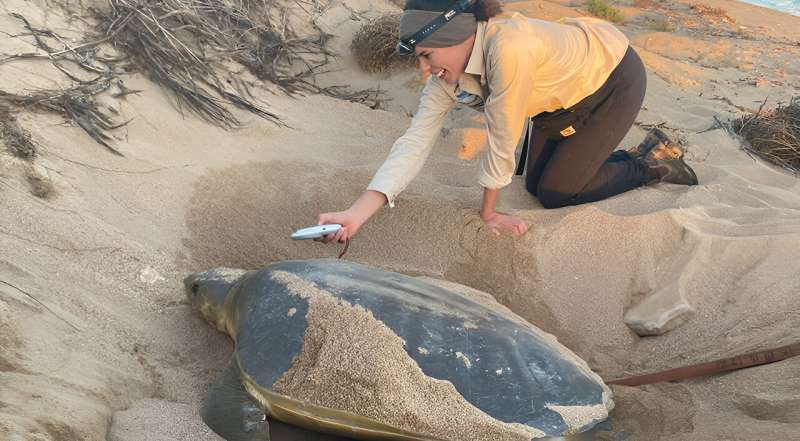This article has been reviewed according to Science X's editorial process and policies. Editors have highlighted the following attributes while ensuring the content's credibility:
fact-checked
peer-reviewed publication
trusted source
proofread
Variable rates of flatback turtles hatching on Western Australia's Pilbara beaches

Climate change will impact the emergence success and sex ratio of flatback turtle hatchlings in the Pilbara region of Western Australia within the next two decades, according to a new study.
The research, published in Global Ecology and Conservation, was a collaboration between The University of Western Australia and the Department of Biodiversity, Conservation and Attractions' North West Shelf Flatback Turtle Conservation Program.
Dr. Malindi Gammon, from UWA's School of Biological Sciences, said marine turtles were very vulnerable to climate change because their eggs were laid in underground nests and the temperature of the sand was critical.
"Previous studies have shown a decline in emergence success from nests with sand temperatures above 31.5°C," Dr. Gammon said. "The sex of a hatchling is also determined by the nest temperature with mostly females produced from warmer nests."
The study assessed the impacts of warmer sand temperatures on the primary sex ratio and thermal mortality thresholds of flatback turtles across 402 Pilbara beaches of the Western Australian coastline.
"We predicted hourly sand temperatures of 32 nesting seasons, from 1986 to 2019, and grouped the beaches into categories of embryonic thermal stress risk ranging from 'very low' to 'very high' in relation to the 31.5°C threshold," Dr. Gammon said.
Ten nesting beaches with different thermal stress risk categories were selected, and the hourly sand temperatures predicted for three climate change scenarios: the recent climate (1986–2015 average); and two future scenarios where average air temperature was 2°C or 4°C higher.
"In the recent climate conditions there was an average emergence success of 76%, and 39% of hatchlings were male," Dr. Gammon said.
"Encouragingly most active nesting beaches had a 'low' thermal risk, but a handful of beaches in the north-easterly region had 'very high' thermal risk exposure, such as Cemetery Beach in Port Hedland where average sand temperatures are already over 32°C.
"Under future climate scenarios, emergence success across the Pilbara region is predicted to decline to 63% with a 2°C increase in average air temperature and just 37% with a 4°C increase."
Senior author, Associate Professor Nicola Mitchell, Deputy Director of UWA's Oceans Institute, said under future climate scenarios, current cooler beaches had an emergence success over 50%, however most hatchlings were predicted to be female.
"These cooler beaches should be considered a high priority for protection because with 2°C of warming, which might occur by 2041 to 2060, these beaches will be producing the only males for the entire North West Shelf flatback turtle population," Associate Professor Mitchell said.
"By triaging Pilbara nesting beaches into three management categories—protect, monitor and mitigate—we can prioritize strategies for proactive management depending on thermal risk."
Co-author Dr. Sabrina Fossette, from DBCA's North West Shelf Flatback Turtle Conservation Program, said the findings were significant at a regional and international scale and could guide conservation planning.
"We can use these predictions to guide conservation planning, particularly as other human-induced impacts occur simultaneously alongside climate change impacts in this region. By identifying beaches of high protection priority, we can make more informed conservation decisions," Dr. Fossette said.
"The research provides a method to predict the viability of the whole marine turtle stock under current and future climate change scenarios, which has not previously been achieved."
The authors acknowledge the traditional owners of the land and sea Country where the flatback turtles live and the study was conducted.
More information: Malindi Gammon et al, Reconstructed and projected beach temperatures reveal where flatback turtles are most at risk from climate change, Global Ecology and Conservation (2024). DOI: 10.1016/j.gecco.2024.e02866
Journal information: Global Ecology and Conservation
Provided by University of Western Australia




















